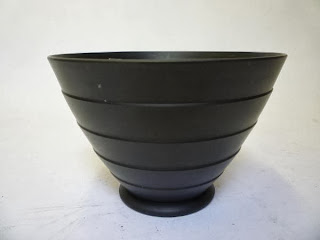Keith Murray wedgwood
minimalist
designs he produced for Wedgwood in the 1930s. His strong, modern
forms have attracted a dedicated following among interior designers
as well as While
many pottery manufacturers in Stoke-on-Trent were closing down during
the Depression in the early 1930s, Josiah Wedgwood & Sons made a
bold decision to commission New Zealand-horn architect, Keith Murray,
to design ranges of affordable mass- produced pottery. Wedgwood
wanted to revive their business by using talentedcither than
ceramics, and Murray had already established his reputation as a
glassware designer for Stevens & Williams.
A WINNING COMBINATION
Although
slow to start, Wedgwood's new range — launched in 1933 - was a
triumph.
This was largely owing to the winning combination of Murray's sleek designs and the matt glazes developed by Norman Wilson. Wedgwood's works manager.
This was largely owing to the winning combination of Murray's sleek designs and the matt glazes developed by Norman Wilson. Wedgwood's works manager.
 |
| Keith Murray wedgwood |
Murray's first range of vases and bowls were
hand thrown and featured incised horizontal fluting, or banding.
They were glazed in plain matt colours, including green and straw, both commonly used on Murray pieces for Wedgwood.
Expect to pay £300-500 for a first-range piece ingood condition and perhaps more for a rarer glaze colour, such as grey - though some lucky individuals have found examples of his work at car- hoot sales.
His shapes are listed in the Wedgwood shape books, the first being 3753; later pieces dated to 1939-40 are found around 4326. Murray's work is nearly always marked on the base .
They were glazed in plain matt colours, including green and straw, both commonly used on Murray pieces for Wedgwood.
Expect to pay £300-500 for a first-range piece ingood condition and perhaps more for a rarer glaze colour, such as grey - though some lucky individuals have found examples of his work at car- hoot sales.
His shapes are listed in the Wedgwood shape books, the first being 3753; later pieces dated to 1939-40 are found around 4326. Murray's work is nearly always marked on the base .
Black beauty body, perfected by
Josiah Wedgwood in the 1760s. Vases are highly sought after, and can
sell for £500-1,500, depending on the size and shape. Marks on the
bases of black pieces are in red.
A black basalt coffee set was produced and is rare. A part set, comprising a coffee pot, milk jug, and sugar bowl could fetch over £1,000. Another set was produced in the less expensive, traditional Queen's ware body — Wedgwood's version of cream ware.
Murray also used copper- and bronze-coloured bodies for items such as tobacco jars. Such pieces now fetch consistently high prices.
Murray
also designed beer tankards and mugs and these fetch around £60-80.
His later slip-cast wares, first introduced in 1936, provide another
fascinating and relatively inexpensive collecting area.
These products include ink stands and cigarette boxes decorated with the same matt glaze colours used in his other work.Changing fashions
These products include ink stands and cigarette boxes decorated with the same matt glaze colours used in his other work.Changing fashions
Continuing
his clean-lined and modern look, around 1936, Murray
made simpler,
classical shapes with a subtle pale green celadon
glaze with some
incised decoration. These are less keenly sought after today, so
prices are lower than those commanded by his early
work.
 |
| Keith Murray wedgwood |
These include the Art Deco style Lotus', as well as 'Iris', and the stylish 'Green Tree". Some of these were applied to both bone china and earthenware. In 1935 a complete dinner set decorated with the Tulip' pattern retailed at .£15 - more than three times the average weekly wage in this period.
Few of these wares were produced, but although they are rare, they are notvalued highly today. Collectors prefer the undecorated, simple shapes for which Murray is best known.
CELEBRATIONS
 |
| Keith Murray wedgwood |
The coronation never happened, owing to Edward's abdication in 1936, and these wares are collectable.
Examples include a mug bearing a portrait of the King and a jug featuring the Royal Arms, both on a moonstone glaze.
Avoid confusing these rare pieces with later commemorative wares featuring blue relief decoration by Arnold Machin on Keith Murray shapes.
Later in his career, Murray resumed work as an
architect while still designing ceramics. Appropriately, in 1940 he
was commissioned to design the new Wedgwood factory in Barlaston,
near Stoke-on-Trent. He finally retired, aged 75, in 1967.

0E9s37F,yLBRi7p31(4Q~~60_35.JPG)
No comments:
Post a Comment